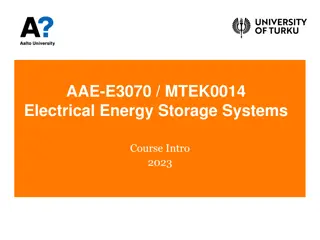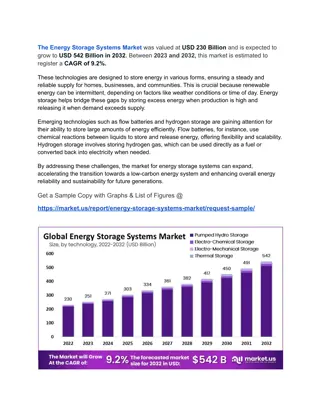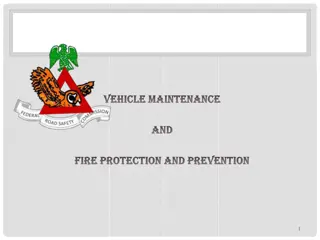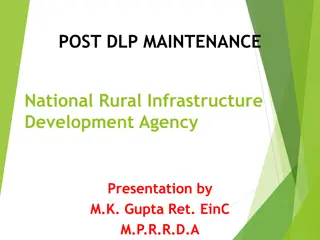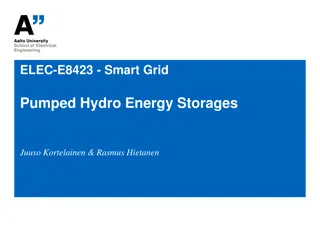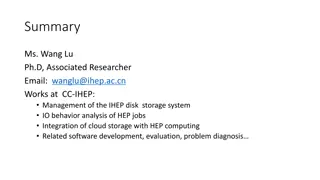Technical Workshop on Implementing Operation and Maintenance Standards for Energy Storage Systems
Workshop hosted by the California Public Utilities Commission to discuss the implementation of Senate Bill 1383 and proposed changes to General Order 167-B regarding Energy Storage System standards. The workshop aims to gather feedback on the proposal, share information on next steps, and provide clarity on the timeline for implementing Operation and Maintenance Standards. Participants are encouraged to submit workshop-related questions for discussion during designated Q&A sections. The Electric Safety and Reliability Branch is a key entity involved in these initiatives.
- Workshop
- Energy Storage Systems
- California Public Utilities Commission
- Operation and Maintenance Standards
- Senate Bill 1383
Download Presentation

Please find below an Image/Link to download the presentation.
The content on the website is provided AS IS for your information and personal use only. It may not be sold, licensed, or shared on other websites without obtaining consent from the author. Download presentation by click this link. If you encounter any issues during the download, it is possible that the publisher has removed the file from their server.
E N D
Presentation Transcript
Technical Workshop on Implementing Operation and Maintenance Standards for Energy Storage Systems per Senate Bill 1383 Electric Safety and Reliability Branch Safety and Enforcement Division March 26, 2024 California Public Utilities Commission 1
Table of Contents Workshop Purpose & Scope Overview of the Electric Safety and Reliability Branch Senate Bills 1383 and 38 Energy Storage Systems Overview Implementation Process: Proposed Changes to GO 167-B Logbook Standards Maintenance Standards Operation Standards Definitions, Industry Codes, Standards, and Organizations, Abbreviations & Acronyms Incident Reporting and Outage Reporting Next Steps California Public Utilities Commission 2
Workshop Purpose & Scope The purpose of this workshop is to: Present the Safety and Enforcement Division s (SED) proposal on Senate Bill (SB) 1383 implementation and revisions to General Order (GO) 167-B and gather feedback on SED s proposal for Energy Storage System (ESS) Standards. Provide information on next steps and SED s implementation timeline for the ESS Operation and Maintenance Standards (O&M Standards). California Public Utilities Commission 3
General Reminders Provide your workshop-related questions via the Q&A function and they will be answered during the designated Q&A sections to our best ability. Please keep your questions related to the proposed changes that are discussed in the presentation. Topics which are not within the scope of this workshop include: Discussion of existing GO 167-B requirements that are not impacted by proposed changes (e.g. Hydroelectric Logbook) Details of energy storage system emergency response and emergency action plans Note the workshop is being recorded and all presentations and recordings will be available on our website afterwards: SB 1383 Technical Workshop California Public Utilities Commission 4
Q&A - How to Submit Your Questions California Public Utilities Commission 5
Overview of the Electric Safety and Reliability Branch California Public Utilities Commission 6
Who is the Electric Safety and Reliability Branch? The Electric Safety and Reliability Branch (ESRB) is part of the Safety and Enforcement Division (SED) of the CPUC (https://www.cpuc.ca.gov/regulatory- services/safety/electric-safety-and-reliability-branch). The mission of ESRB is to enforce state statutes and CPUC rules and regulations regarding the safety and reliability of electric facilities, communication facilities, and power plants that are within the jurisdiction of the CPUC. Through audits, inspections, and investigations of incidents, outages, and/or system problems, ESRB works to ensure that these facilities are operated and maintained in a safe and reliable manner to protect and promote public health and safety. California Public Utilities Commission 7
Understanding ESRB General Orders ESRB enforces the following CPUC General Orders (GO): GO 95: Rules for Overhead Electric Line Construction for Electric and Communications Facilities GO 128: Rules for Construction of Underground Electric Supply and Communication Systems GO 165: Inspection Requirements for Electric Distribution and Transmission Facilities GO 166: Standards for Operation, Reliability and Safety During Emergencies and Disasters GO 167-B: Enforcement of Maintenance and Operation Standards for Electric Generating Facilities GO 174: Rules for Electric Utility Substations California Public Utilities Commission 8
What is GO 167-B? The purpose of this General Order is to implement and enforce standards for the maintenance and operation of electric generating facilities and power plants so as to maintain and protect the public health and safety of California residents and businesses, to ensure that electric generating facilities are effectively and appropriately maintained and efficiently operated, and to ensure electrical service reliability and adequacy. Current version of GO 167-B: https://www.cpuc.ca.gov/-/media/cpuc- website/divisions/safety-and-enforcement-division/documents/go-167-b.pdf California Public Utilities Commission 9
Enforcement of GO 167-B Key enforcement of GO 167-B includes routine Planned Audits, Inspections and Safety Investigations of generating facilities. The components of our audits include: 1. Records (document) Review Compliance documents and maintenance records Training and emergency drill records Policies & Procedures Outage Information Safety records 2. Field/Site Visit Equipment Inspections Review onsite documentation Review electronic records (O&M, Logbook) Observe safety practices and plant operations Interview staff 10 California Public Utilities Commission 10
Enforcement of GO 167-B cont'd 3. Report Discloses and summarizes all findings and observations to Facility Management Issued within30 60 days of the field visit 4. Response from GAO Should include documentation that any deficiencies have been resolved or are scheduled to be resolved Typically received within30 days of the issuance of any report or other notification for correction Any additional follow up (i.e. visit, correspondence) as needed 11 California Public Utilities Commission 11
GO 167-B: Generating Assets and Exemptions GO 167-B: implements and enforces standards for the maintenance and operation of electric generating facilities and power plants (aka Generating Assets). Generating Assets includes thermal, fossil, and renewable facilities such as solar thermal, solar photovoltaic (PV), geothermal,and wind turbines. Generating Asset as defined by GO 167-B does not include: o nuclear generating facilities o qualifying facilities and/or cogeneration facilities o a facility owned by a local publicly owned electric utility o a facility at a public agency that is used to generate electricity for water or wastewater treatment o a facility owned by a city and county operating as a public utility o an onsite generating unit used to exclusively serve that customer s load California Public Utilities Commission 12
GO 167-B: Generating Asset Requirements by Facility Size Requirements for Generating Assets by size of facility: Small Facilities - Generating Assets less than 1 MW o Exempt from enforcement of the operation and maintenance standards but shall cooperatein any (but not limited to) Commission or SED Audit, Inspection or Investigation. Medium Facilities Generating Assets that are 1 MW but less than 50 MW o Exempt from filing requirements (except Safety Incident Reporting) but required to maintain conduct in operations, maintenance, and logbooks in a manner consistent with prudent industry practice. Large Facilities Generating Assets 50 MW and greater o Subject to all applicable Operationsand Maintenance Standards o Required to comply with annual compliance filings, Outage Reporting and Safety IncidentReporting California Public Utilities Commission 13
GO 167-B: Operation and Maintenance Standards for Electric Generating Facilities Section 5 Generator Logbook Standards (Thermal Energy): requires Generating Asset Owners (GAOs) to maintain facility logbooks in conformance with GO 167-B logbook standards. Section 7.1 Generator Maintenance Standards: requires all GAO s generating asset maintenance practices and policies to comply with the maintenance standards of GO 167-B. Guidelines for compliance are available. Section 8.1 Generator Operation Standards: requires all GAOs to operate their generating assets in compliance with the operation standards of GO 167-B. Guidelines for compliance are available. Section 9 CAISO Outage Coordination Protocol: requires all GAOs to comply with ISO s Outage Reporting Section 10.0 Information Requirements: requires GAOs to respond to SED s information requests regarding a Generating Asset reasonably related to the requirements of the GO. California Public Utilities Commission 14
GO 167-B: Operation and Maintenance Standards for Electric Generating Facilities Section 10.4 Safety Incident Reporting requires a GAO report safety incidents within 24 hours of its occurrence which meet GO 167-B criteria. Section 11 Audits, Inspections and Investigations: requires cooperation with SED and Commission staff during these processes and investigations. Sections 12, 13, and 14: pertain to violations, the Commission process for addressing alleged violations of the general order, including the imposition of fines, and sanctions that can be imposed against a GAO for violations of GO 167-B. Section 15 Miscellaneous Provisions: establishes ongoing reporting requirement obligations for all GAOs not exempt from GO 167-B. California Public Utilities Commission 15
Senate Bills 1383 and 38 California Public Utilities Commission 16
Senate Bill (SB) 1383 Senate Bill 1383 (Hueso, 2022) pertains to electric storage facilities (i.e. energy storage systems). Requires the Commission to implement and enforce standards for the maintenance and operation of facilities for the storage of electricity owned by an electrical corporation or located in the state. Also requires the California Independent System Operator (CAISO) to maintain records of storage facility outages and to provide those records to the Commission on a daily basis. Due to our mission to enforce GO 167-B, ESRB has been tasked with implementing the requirements ofSB 1383. California Public Utilities Commission 17
Senate Bill (SB) 38 Senate Bill 38 (Laird, 2023) pertains to battery energy storage facilities. Requires each battery energy storage facility owned by an electrical corporation or located in the state to have an emergency response and emergency action plan that covers the premises of the battery energy storage facility. Requires the owner or operator of the facility to develop a plan and coordinate with the local emergency management agencies, unified program agencies, and local first response agencies. In developing the emergency response and emergency action plan, the owner and operator of the ESS facility shall: o Coordinate with local emergency management agencies and other first response agencies; o Submit the emergency response and emergency action plan to the county and city where the facility is located. California Public Utilities Commission 18
Implementing SB 38 in ESRBs Audits For SB 38 implementation: 1. ESRB will issue a document request as part of its pre-audit data request for the battery energy storage facility s emergency response and emergency action plan to ensure compliance with SB 38 and GO 167-B (e.g. Operating standards 6 and 20). The request and review of these documents will become part of our routine document review for all battery energy storage systems during our audits. 2. During the on-site audit or inspection, ESRB will confirm site facilities comply with the documents received for the emergency response and emergencyaction plan. California Public Utilities Commission 19
Energy Storage Systems Overview California Public Utilities Commission 20
What is an Energy Storage System? An Energy Storage System or ESS is a technology that is capable of absorbing energy, storing it for a period of time, and thereafter dispatching the energy as provided in Public Utilities (PU) Code 2835-2839 ( Energy Storage Systems ). PU Code 2835-2839 states that an energy storage system shall do one or more of the following: (A) Use mechanical, chemical, or thermal processes to store energy that was generated at one time for use at a later time. (B) Store thermal energy for direct use for heating or cooling at a later time in a manner that avoids the need touse electricity at that later time. (C) Use mechanical, chemical, or thermal processes to store energy generated from renewable resources for use at a later time. (D) Use mechanical, chemical, or thermal processes to store energy generated from mechanical processes that would otherwise be wasted for delivery at a later time. California Public Utilities Commission 21
Projected Energy Storage System Capacity in California Projected Storage Capacity 2023-2045 (MW)* 45,000 40,000 35,000 30,000 25,000 20,000 15,000 10,000 5,000 - 2023 2024 2025 2026 2028 2030 2032 2033 2035 2040 2045 * Per IRP portfolio transmitted to the CAISO as part of 2023-24 Transmission Planning Process California Public Utilities Commission 22
Implementation Process: Proposed Changes to GO 167-B Overview California Public Utilities Commission 23
SB 1383 Implementation and Overview of Changes to GO 167-B ESRB s proposed updates to GO 167-B to comply with the requirements of SB 1383 include: 1. Updating the list of definitions to include energy storage systems (ESS) and energy storage system owners (ESSO) in Section 2. 2. Updating and revising sections of GO 167-B that are relevant to ESS including: Logbook Standards: Adding logbook requirements for all large resources in Section 4 and Appendix A Maintenance Standards: Revising the maintenance standards to apply to ESS in Section 6 and Appendix C Operation Standards: Revising the operation standards to apply to ESS in Section 7 and Appendix D o In an addedAppendix E updated applicable Industry Codes, Standards, Organizations, and Abbreviations and Acronyms Outage Reporting: Applying Section 8.0 (CAISO Outage Coordination Protocol) reporting rules to ESSs. California Public Utilities Commission 24
SB 1383 Implementationand Overview of Changes to GO 167-B ESRB s proposed updates to GO 167-B to comply with the requirements of SB 1383 include: 3. Changes to the Incident Reporting Requirements o Renamed from Safety-Related o Changed Reporting Criteria o 20-Day Report replaces 5-Day Report o Specified list of Information required in Initial Report and 20-Day Report 4. Miscellaneous Updates o Appendix A: General Duty Standards for Operations and Maintenance o Removed References to Committee , which no longer exists o Removedinitial deadlines that were specified in the original GO o Replaced ISO s Scheduling and Logging in California (SLIC) with Outage Management System (OMS) California Public Utilities Commission 25
Implementation Process: Proposed Changes to GO 167-B Logbook Standards California Public Utilities Commission 26
Logbook Standards Revisions There are two Logbook Standards included in GO 167-B: Appendix A & Appendix B. Appendix A: Generating Asset and ESS Logbook Standards o Replaced previous Generator Logbook Standards (Thermal Energy) o Logbook requirementin Appendix A: 1. Control Operator Log:Each facility shall maintain this log in chronological history of operation and maintenance activities during the shift. 2. Facility status Entry: Part of the Control Operator Log in which each facilitymust record overall facility status entry at least once a day. 3. Exceptions: Allows separate logbooks for special events such as out of service equipment and work authorization in addition to Control Operator Log. Appendix B: Hydroelectric Energy Logbook Standards o No changes to Appendix B which applies exclusively to hydro facilities California Public Utilities Commission 27
Logbook Standards Revisions contd Appendix A revisions at a glance: Revised language to include all types of generating assets including ESS, fossil and renewable facilities such as solar thermal, solar photovoltaic (PV), geothermal, and wind turbines. Facility Status Entry Log o Removed existing thermal plant-specific clauses such as condenser pressure and boilerchemistry. o Added general operating parameters such as weather information, dispatch records and state of charge for ESS. Control Operator Log o Added language for ESS operation process such as charges, discharge. o Added a log requirement for critical operation parameters to comprise all types of generating assets and equipment. California Public Utilities Commission 28
Logbook Standards Revisions contd Exceptions: Existing logbook standards allow for two exceptions which are not required to recorda facility s activities into the Control Operator Log. Our proposed changes would add a third exception. Exception 1: Equipment Out of Service (OOS) Logbook: Log for equipment that is out- of-service to avoid duplication in Control Operator Log. Exception 2: Work Authorization Logbook: Log for special activities commonly referred to as clearances during construction,overhauls, or major works. Exception 3:Work Order Management System or Electronic Database System: Log for periodic maintenance activities to avoid logbook requirement of Facility Status Entry Log and Control Operator Log. California Public Utilities Commission 29
Questions? California Public Utilities Commission 30
Implementation Process: Proposed Changes to GO 167-B Maintenance Standards California Public Utilities Commission 31
Revision to Maintenance Standards The current version of GO 167-B contains 18 Maintenance Standards (MS) covering safety, responsibilities, maintenance procedures, chemistry control, engineering and technical support. Updates include changes to incorporate ESS components and apply the latest industry standards and emerging technologies to enhance problem resolution and engineering and technical support. MS-1 Safety oNo changes MS-2 Organizational Structure and Responsibilities oUpdated language (i.e. station to facility) MS-3 Maintenance Management and Leadership oNo changes MS-4 Problem Resolution and Continuing Improvement oIncorporated ESS into standard oIncorporated problem prevention as a practice that is to be fostered by the company through the application of industry best practices and emerging technologies for the safety and reliability of both the GA and ESS. California Public Utilities Commission 32
Revision to Maintenance Standards contd MS-5 Maintenance Personnel Knowledge and Skills o Updated language (i.e. plant to facility) MS-6 Training Support o No changes MS-7 Balance of Maintenance Approach o Included ESS to balance of maintenance approach o Clarified that maintenance procedures and documents should include all GA and ESS equipment and all integral parts to delivering power to the grid o Removed "owned by the generation owner" to avoid redundacy MS-8 Maintenance Procedures and Documentation o Updated language (i.e. plant to facility) MS-9 Conduct of Maintenance o Updated language (i.e. plant to facility) California Public Utilities Commission 33
Revision to Maintenance Standards contd MS-10 Work Management o Updated to clarify that work management is to be focused around "priority" in maintaining reliable facility operation and not "value" o Updated language (i.e. station to facility) MS-11 Facility Status and Configuration o Updated to include safety as an item that is to be supported when managing station activities MS-12 Spare Parts, Material and Services o Updated sentence structure (no substantive changes) MS-13 Equipment Performance and Material Condition o Updated to include corrosion as an issue that is to be considered when developing strategies and/or methods to anticipate, prevent, identify and resolve equipment issues California Public Utilities Commission 34
Revision to Maintenance Standards contd MS-14 Engineering and Technical Support o Updated to include technical support activities as actions that are to be conducted complementary to engineering activities to optimize equipment performance for reliable facility operation o Updated to include implementation of industry best practices and emerging technologies by engineering and technical support to ensure the facility is operated and maintained within operating parameters defined by facility design MS-15 Chemistry Control o Updated to clarify that Chemistry Controls are to optimize chemical conditions during all phases of facility operation MS-16 Regulatory Requirements o Updated language (i.e. plant to facility) MS-17 Equipment History o No changes MS-18 Maintenance Facilities and Equipment o No changes California Public Utilities Commission 35
Questions? California Public Utilities Commission 36
15 Minute Break California Public Utilities Commission 37
Implementation Process: Proposed Changes to GO 167-B Operation Standards California Public Utilities Commission 38
Revision to Operation Standards The current version of GO 167-B contains 28 Operation Standards (OS) that cover safety, responsibilities, leadership, training, procedures, conduct, inspections, security, record keeping, etc. Updates included changes to address physical clearances, emergency planning and coordination with local first responders, grid emergencies, readiness, andcorrosion. OS 1 Safety oAdded and ESSO OS 2 Organizational Structure and Responsibilities oUpdated language (i.e. plant to facility) and removed and OS-3 - Operations Management and Leadership oNo changes OS 4 - Problem Resolution and Continuing Improvement oAdded and ESSO and removed owner OS 5 - Operations Personnel Knowledge and Skills oUpdated language (i.e. plant to facility) California Public Utilities Commission 39
Revision to Operation Standards contd OS 6 - Training Support o Added and ESSO and removed owner o Changed Personnel are trained commensurate with their duties. to Personnel are trained to ensure safe and reliable facility operation. OS 7 - Operation Procedures and Documentation o Added ESS language and charging, discharging, normal operation, failure detection, restoration o Added Procedure shall be reviewed annually to ensure current procedures are up-to-date and OEM recommendations are implemented. OS 8 - Plant Status and Configuration o Changed plant and station to facility OS 9 - Engineering and Technical Support o Updated language (i.e. plant to facility) o Added and technical staff o Added requirements for software updates for cyber security, safety, reliability, and operational purposes California Public Utilities Commission 40
Revision to Operation Standards contd OS 10 - Environmental Regulatory Requirements o Updated language (generating asset to facility) OS 11 - Operations Facilities, Tools and Equipment o Added including housekeeping, tool storage, and equipment storage OS 12 - Operations Conduct o Updated language (plant and GAO to facility) o In Section B, changed Basic rules of conduct to Professional conduct o In Section D, added Anyone shall have the right to stop work if they see an unsafe condition OS 13 - Routine Inspections o Updated language (plant to facility) o Added ESSO o In Section A, added including but not limited to and added Operating Standards o In Section D, added and trending California Public Utilities Commission 41
Revision to Operation Standards contd OS 14 Clearances o Updated language (GAO to Generating Asset or ESS Owner ) o Added Lock-out-tag-out o Added Section D, Physical separation and clearances must be observed and maintained OS 15 - Communications and Work Order Meetings o Added and/or ESS and or ESSO o Updated language (i.e. plant to facility) OS 16 - Participation by Operations Personnel in Work Orders o Updated language (i.e. plant to facility) OS 17 - Records of Operation o Added or ESS and or ESSO OS 18 - Unit Performance Testing o Added or ESSO California Public Utilities Commission 42
Revision to Operation Standards contd OS 19 - Emergency Grid Operations o Updated language (plant to facility) o Added or ESSO o Added Section E, ESSO prepare for periods of stress or shortage, by ensuring that availability is adequately monitored and maintained. OS 20 - Preparedness for On-Site and Off-Site Emergencies o Added and/or ESS and or ESSO o Updated language (i.e. plant to facility) o Added Section D, The GAO and ESSO develops a plan to coordinate with local emergency management agencies, unified program agencies, and local first response agencies. o Added to Section E, The owner or operator of each ESS facility shall develop and submit an emergency response and emergency action plan. The owner or operator of the ESS facility shall submit the emergency response and emergency action plan to the county, local emergency management agencies, local first response agencies, and if applicable, the Authority Holding Jurisdiction (AHJ) and the city where the facility is located.. California Public Utilities Commission 43
Revision to Operation Standards contd OS 21 - Plant Security o Added or ESSO o Updated language (i.e. plant to facility) OS 22 Readiness o Added or ESSO o Changed severe weather conditions to emergencies OS 23 - Notification of Changes in Long Term Status of a Unit o Added or ESSO OS 24 - Approval of Changes in Long-Term Status of a Unit o Added ESS and or ESSO OS 25 - Transfer of Ownership o Added or ESSO OS 26 - Planning for Long-Term Unit Storage o Added or ESS and or ESSO California Public Utilities Commission 44
Revision to Operation Standards contd OS 27 Flow Assisted Corrosion o Changed title to Corrosion Control o Rewrote OS 27: Where circumstances require it, the GAO or ESSO shall prepare and follow a comprehensive corrosion mitigation and control program for all types of corrosions to identify vulnerable systems, implement appropriate corrective actions, and preventive measures to maintain facilities with designed performance condition. OS 28 - Equipment and Systems o Added or ESSO o Updated language (i.e. plant to facility) and removed Ref. Standard No. California Public Utilities Commission 45
Questions? California Public Utilities Commission 46
Implementation Process: Proposed Changes to GO 167-B Appendix E California Public Utilities Commission 47
Updates and Revisions to Appendix E: Applicable Codes, Standards, and Regulations Appendix E identifies standards to augment Operations and Maintenance Standards. ESRB expanded the list of organizations, agencies, associations, industries, and codes in the table in Appendix E to include those with standards and regulations specifically applicable to ESS. Some of these additions include: California Building Code California Electrical Code California Fire Code California Mechanical Code International Building Code International Electrotechnical Commission International Fire Code National Electric Safety Code California Public Utilities Commission 48
Updates and Revisions to Appendix E: Applicable Codes, Standards, and Regulations Samples of applicable codes and standards for ES systems include: Agency Codes, Standards, Regulations OSHA 29CF1910 Occupational Safety and Health Standards Commissioning, and Performance Testing Standards OSHA 68 Standard on Explosion Protection by Deflagration Venting 69- Standard on Explosion Prevention 70B Recommended Practice for Electrical Equipment Maintenance 72 - National Fire Alarm and Signaling Codes 853 - Standard for the Installation of Stationary Fuel Cell Power Systems (2020) 855 Standards for the Installation of Stationary Energy Storage Systems 1660 Standard for Pre-Incident Planning NFPA 1642 Standard for Lithium Batteries 1741 Standard for Inverters, Converters, Controllers, and Interconnection System Equipment for Use with Distributed Energy Resources 1973 Standard for Batteries for Use in Stationary, Vehicle Auxiliary Power and Light Electric Rail Applications 9540 Standards for Energy Storage Systems and Equipment 9540A Test Methods for Evaluating Thermal Runaway Fire Propagation in Battery Energy Storage Systems UL 1547 Standard for Interconnection and Interoperability of DERs w Associated Electrical Power System Interfaces 2030.2.1-2019 Guide for Design, Operation, and Maintenance of BESS IEEE IEC 62619 - Safety Requirements for Secondary Lithium Cells and Batteries for use in Industrial Applications 55000 - Asset Management Standards 13374 - Condition Monitoring and Diagnostics of Machines ISO California Public Utilities Commission 49
Questions? California Public Utilities Commission 50


